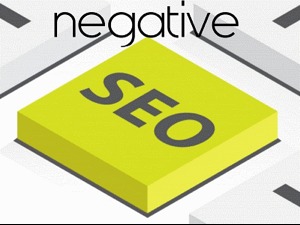Types of Negative SEOApr112017

Negative SEO Defined
A person or entity can easily unleash a slew of below-the-belt tactics with the intent to decrease a website’s ranking in search engine results, and/or to ruin their online reputation.
Negative SEO intrusions may include:
Creating and sending spam links to your website
Grabbing your website content and placing it somewhere else
Posting fraudulent reviews (or mentions) about your business/products/services online
Creating fraudulent social media profiles with intent to tarnish your reputation
Pointing links to your site with keywords that don’t apply to your content
All out hacking of your entire website
Off Page and On Page Negative SEO May Include:
Spam Links
Generally will come from link farms / private blog networks (PNB), purely with the intention of degrading your index ranking and increasing their index ranking.
Google's Penguin algorithm in 2012 made it more difficult for PNBs to be effective. When the Googlebot identifies backlinks coming from PNBs Google most often flags them as a link scheme which ultimately leads to a penalty.
Link raiders will also shoot exact match text links to a ranking page using unrelated industry exact match anchors with the goal of skewing up your sites anchor text ratio. Another variation is for the attack to implicate your target keywords so your link profile appears to be manipulating it.
Early detection of spam links to your website will help you halt any damage done, so monitor your backlinks on a regular basis. Routinely audit your backlinks profile growth, by checking the number and identity of referring domain names. Unnatural links pop out if your website is based in the USA, but you have a number of links connected to your site coming from another country. A sudden increase in referring sites or backlinks is a red flag telling you to investigate.
Monitor your website backlinks using:
Bing Webmaster Tools, free after registration, http://www.bing.com/toolbox
Google Webmaster Tools, free after registration, https://www.google.com/webmaster
Ahrefs Backlink Report, free and paid versions,
http://linksphinx.com/backlink-checker-tools/#ahrefs-backlinks-report
SEMrush, free and paid versions
SEO SpyGlass, free and paid versions, http://www.seo-spyglass.com/
How to Pursue Malicious Backlinks
If you determine beyond a shadow of a doubt, you have unnatural links directed to your site, there are several methods to report for removal:
Find the Contact information for the site that’s sending your website links. Send an Email asking (politely) for them to Remove the link.
Check which pages on your website are receiving the unwanted backlinks. If they’re low quality pages, then delete them (404 / 410) in lieu of the links. You may be able to rewrite those pages with a new file name, or incorporate the content into an established webpage. Keep in mind, too many 404 pages don’t set well with Google, so in conjunction with deleting the webpage you should also Disavow the unwanted backlinks.
If Google has given your site a Penalty, and your site is not worth your time and trouble cleaning up the backlinks, then discard the domain and start over.
If webmasters/site owners aren't responding to your link removal Email, if you have too many backlinks you need to get rid of, and you don't want to abandon your website - then absolutely Disavow all the links through Bing and Google.
Once the Disavow takes hold, you will see a drop in your site traffic. The unnatural backlinks were sending traffic to your site. When the links disappear it will trigger a flag within Google/Bing telling them your site is less interesting to searchers. Traffic may decline drastically, and there's no way of predicting how this will affect your site long term.
Google Disavow Tool, https://www.google.com/webmasters/tools/disavow-links-main
Bing Disavow, https://www.bing.com/webmaster/help/how-to-disavow-links-0c56a26f
Note: An over all safeguard if your site is using Wordpress is to promptly upgrade to new versions when they’re released. Don’t forget to remove or update new Plugin versions.
An interesting case study of Negative SEO due to spam links:
http://www.nichepursuits.com/survival-knife-project-update-making-a-comeback-from-negative-seo/
Online Fraudulent Negative Reviews
Negative reviews posted online about you and/or your business can be damaging to your bottom line. People wanting to attack your credibility can easily post online. Monitor directories where reviews can be posted. Sign into each directory to Flag those reviews you’re positive are fraudulent.
How to Flag a Review on Google My Business for Removal
Navigate to Google Maps, http://maps.google.com
Type in the Search box for your business name or address.
From the Search Results select your business.
Scroll to Review Summary
Under the Average Rating, click on number of reviews.
Scroll to the Review you want to Flag and click on the flag icon.
Fill out the Report Form and submit.
Other online sites you can register at to monitor your reviews:
Amazon Customer Reviews
Angie's List
CitySearch
Foursquare
Google My Business, Google+
Local.com
TripAdvisor
Yahoo Local Listings
Yelp
Content Scraping
Scrapers grab content from your website, and then post it as soon as they can to other sites, sometimes numerous times.
When Google detects duplicate content, they select one version to index. If Google comes across the copied content first, your site may be algorithmically de-ranked, leaving the scrapers site with the index position.
How to Check for Duplicate Content
Choose a unique paragraph from your website, put quotation marks around it – and paste it into Google search.
If you have multiple pages to check, use a tool such as Copyscape, http://www.copyscape.com/plagiarism-detection/, by entering your website page URL.
How to Pursue Content that’s been Copied without Permission
First Email the website that’s displaying your content, and ask them to remove it. Most often you won’t receive a response.
File a DMCA (Digital Millenium Copyright Act) complaint with Google, via the Google DCMA Dashboard, https://www.google.com/webmasters/tools/dmca-dashboard
You’ll need to file a separate DCMA complaint form for each page that’s infringing on your copyright, and request removal from Google. Read the full instructions from the legal help resource at Google Support, https://support.google.com/legal/troubleshooter/1114905?hl=en
You should review the complete DCMA removal process guide from the Copyright Alliance prior to filing.
Note: A DMCA removal request should be your last resort in protecting your copyrighted content online. This should only be used when a site is blatantly infringing your copyright without attribution and will not respond to requests to remove or attribute the content.
Return
